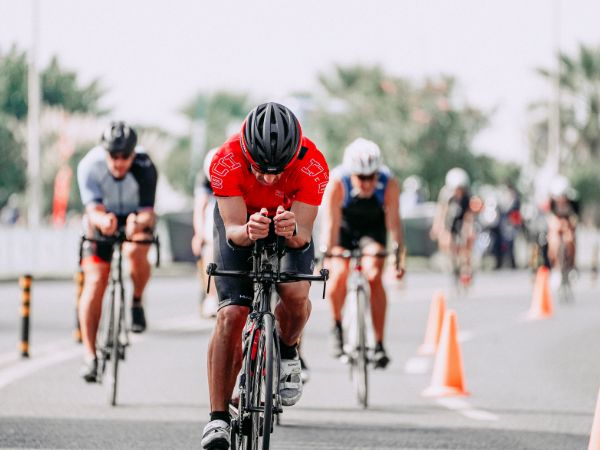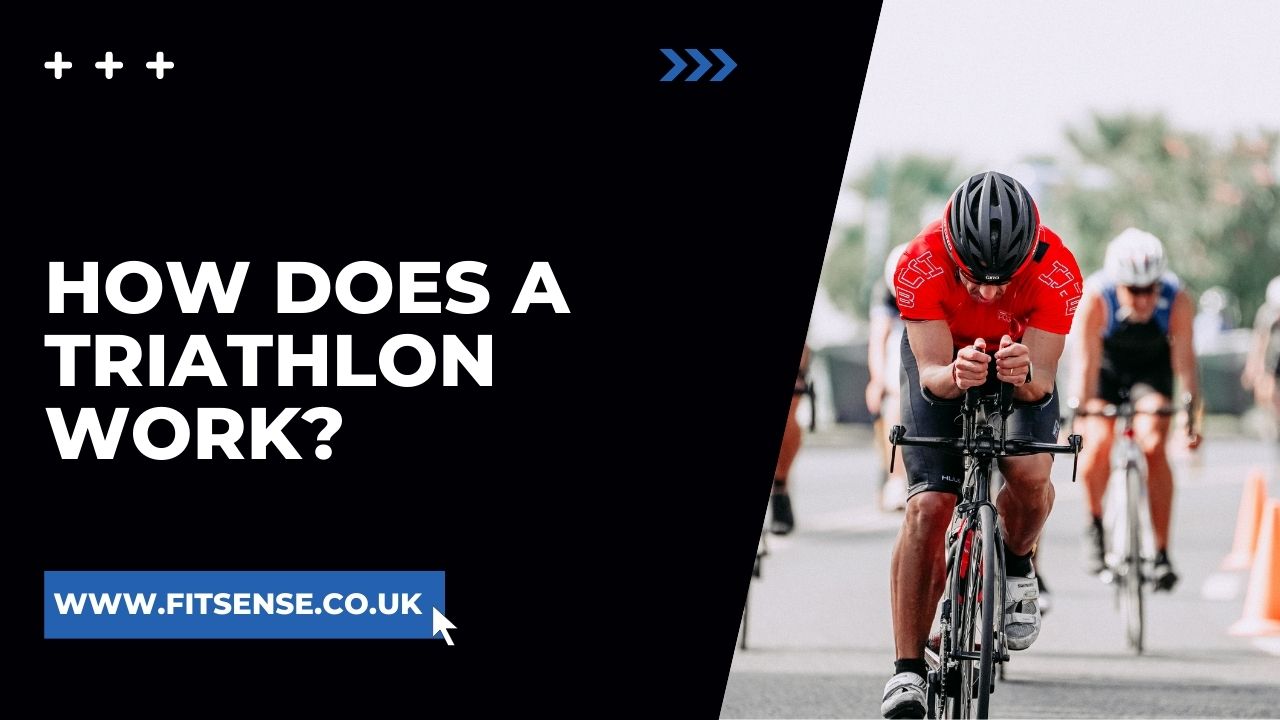Triathlons have gained popularity recently, capturing the attention of athletes and fitness enthusiasts everywhere. Swimming, cycling, and running are the three demanding disciplines combined in this captivating sport, which challenges competitors’ physical and mental boundaries. Now, you may ask how does a Triathlon work. Keep reading this article, and you’ll learn about it briefly.
Participants in triathlons need to be exceptionally physically fit and mentally tough. Each discipline has unique difficulties that put an athlete’s abilities to the test in various ways. The swim leg demands strength, technique, and confidence in open water, and the bike leg demands stamina, power, and tactical decision-making as athletes. Finally, the run leg demands mental toughness and endurance.
Triathlons test not only your physical limits but also your willpower and determination. Competitors must push over self-doubt, stay focused, and keep a positive attitude throughout the race.
What Is A Triathlon?
A triathlon is fundamentally a multisport competition that involves the three sports of swimming, cycling, and running. The Greek roots of the word “triathlon” are “tri,” which means three, and “Athlon,” which means competition.
Triathlons are known for being physically and mentally taxing and are generally used to measure athletic prowess. It has gained immense popularity due to its inclusive nature, accommodating participants of various fitness levels and age groups.
Disciplines of Triathlon
These are the three disciplines of Triathlon-
Swimming
Swimming is the first discipline of a triathlon. This segment is often completed on rivers, lakes, or other open-water bodies. Swimming distances can change depending on the competition, ranging from sprints to lengthy durations like the Olympic or Ironman triathlons.
Cycling
Participants move on to the bike stage after the swim leg. Cyclists follow a predetermined route that may include level roads or strenuous hilly terrain. Depending on the particular triathlon event, different distances are covered in the bike leg. Competitors may ride road bikes or specialized triathlon bikes with aerodynamic features to increase speed and efficiency.
Running
The run is a triathlon’s third and final leg. Participants move from cycling to running and walk the predetermined distance. Athletes must deal with the cumulative weariness from cycling and swimming throughout the run phase, which may be mentally and physically taxing. Running with proper technique, endurance, and mental toughness is essential for finishing this leg.
Why Do A Triathlon?
A triathlon is a demanding endurance race, and completing one is impressive. A triathlon requires extensive preparation and commitment, but the sense of achievement from finishing is unparalleled. Its training is a great way to improve your overall fitness, and you’ll get stronger, fitter, and more in shape.
Here are a few advantages of participating in a triathlon:
Increased fitness: Training for a triathlon will help you gain more stamina, strength, and endurance.
Weight reduction: Triathlon training can aid calorie burning and weight loss.
Reduce Stress: Physical activity is a terrific technique to reduce stress and enhance mental health.
Better sleep: Training for a triathlon can improve your nighttime sleep.
Sense of accomplishment: Finishing a triathlon is a significant achievement that will increase your confidence.
Socialization: Participating in triathlons is a terrific way to make new friends and network.
Can I Do A Triathlon?
You don’t have to be an elite athlete to compete in a triathlon; anyone with any fitness level can do it. I advise starting with a sprint-distance triathlon if you’re new to the sport. Sprint triathlons are shorter than other distances, making them an excellent chance to try the sport and decide if you like it.
Consider the following factors while determining if you can complete a triathlon:
Your current fitness level: You’ll be well on your way to finishing a triathlon if you’re already active and in good shape. Start by progressively stepping up your activity level and developing your endurance if you’re not as active.
Your swimming ability: It’s crucial to swim easily because it’s one of the three triathlon disciplines. By enrolling in swimming lessons, you can practice swimming laps in a pool if you aren’t a strong swimmer.
Your bike and gear: For a triathlon, you’ll need a bike, a wetsuit, swim goggles, and other equipment. You can rent or borrow this equipment from a buddy if you don’t already have any of it.
Your mental toughness: In addition to being physically taxing, triathlons also present mental challenges. You’ll need to be mentally prepared to push yourself through the challenging portions of the race.
I strongly advise you to pursue your triathlon goals if you consider doing one. Triathlons are a fantastic opportunity to push yourself, get fitter, and have fun.
How Does a Triathlon Work
If you want to participate in a Triathlon, there is a process you need to follow one by one. From registering to finishing the sport, it’ll be easy if you have an overall idea of the process.
Sign Up for a Triathlon
The steps to register for a triathlon are as follows:
Step 1:Find a Triathlon
You can select a triathlon that is right for you because they are hosted worldwide. You can look up local triathlons online or ask your neighborhood triathlon club or running shop.
Step 2: Read the race details
Once you’ve located a triathlon, carefully review the race information. This will provide information about the swim, cycle, and run distances and the race’s date, time, and venue.
Step 3: Register for the race
You’ll need to give your contact information and payment information to sign up for the race. Your age, gender, and swimming prowess may also be requested.
Step 4: Pay the registration fee
The cost of registration varies based on the event. Registering early is a good idea because certain races offer discounts for early registration.
Step 5: Prepare for the race!
Start your preparation for the race once you have registered. You’ll need to prepare for the triathlon’s several events and the race’s overall length.
What Triathlon Gear Do You Need?
All you need as a novice are these 5 items:
- Swimsuit: A swimsuit is a neoprene suit that helps you stay warm in cold water. It is also important for buoyancy and streamlining.
- Goggles: Your eyes are shielded from chlorine and water by swim goggles. They also aid in improving your underwater vision.
- Bike: The essential piece of equipment for a triathlon is a bike. You’ll need a bike that fits you well and is comfy.
- Helmet: For safety, a bike helmet is necessary. In the event of a crash, it safeguards your head.
- Running shoes: Running shoes are essential for providing cushioning and support. They ought to fit you nicely and be cozy.
Training For A Triathlon
Triathlon training requires patience, commitment, and a well-thought-out plan. Here are some general pointers for triathlon training:
- Start early: Building the stamina and fitness required to finish a triathlon takes time. At least 12 weeks before your race, begin your training.
- Set realistic goals: Try not to attempt too much too quickly. Start with a sprint triathlon and progress to longer distances over time.
- Listen to your body: Don’t overexert yourself, and take rest days as needed.
- Vary your workouts: Don’t repeat the same exercises repeatedly. Change things up to keep your body on its toes and avoid boredom.
- Include cross-training: A wonderful strategy to increase your general fitness and avoid injuries is to cross-train. Swimming, biking, running, and yoga are effective cross-training exercises for triathlons.
- Fuel and hydrate properly: Consuming the right food and liquids is critical during training and race day. Your performance will improve as a result, and you won’t crash.
- Practice transitions: The interval between each triathlon discipline is known as a transition. Practicing transitions is crucial so you can switch gears effectively and rapidly.
- Reduce your training volume: You must trim your training in the weeks before your race. This entails progressively lowering your workouts’ intensity and duration. You can rest and heal, making you fresh on race day.
Mental Preparation
Mental Preparation is important for participating in this sport-
Visualizing Success: By mentally practicing their race and visualizing themselves swimming, cycling, and running with strength and confidence, athletes can visualize success. Performance can be improved by visualizing the desired results and overcoming obstacles.
Developing Mental Resilience: Building mental toughness is essential to conquering the unexpected challenges that can arise during triathlons. Athletes can improve their resilience by engaging in mental training, practicing meditation, or seeing sports psychologists. This will help them stay focused, overcome obstacles, and keep a positive attitude during the race.
Managing Pre-Race Anxiety: Pre-race jitters are typical, and developing coping mechanisms can help one become more composed and focused. Pre-race preparations, breathing exercises, and encouraging self-talk can all help reduce anxiety and increase mental clarity.
Goal Setting
Setting Specific, realistic goals is essential for triathlon training. Goals should be specific, measurable, achievable, relevant, and time-bound (SMART). Having measurable goals helps you focus and stay motivated, whether reaching personal milestones, finishing the race in a specific time, or increasing your overall performance.
The Swim
The triathlon’s swim leg is the quickest leg of the event. The swim leg of a triathlon marks the beginning of the race and often takes place in open water. There are typically three types of swim starts:
Mass Start
In a mass start, all competitors plunge or sprint into the water simultaneously to start the swim portion. This kind of start can be thrilling but difficult because it requires squeezing through a dense field of swimmers. Athletes must discover their own space and develop a smooth rhythm.
Wave Start
In a wave start, competitors are divided into smaller waves according to their age or skill level. A more controlled and less crowded swim is possible because each wave starts at a specific time. For beginners or those who prefer less congested situations, wave beginnings can make the experience easier.
Time-Trial Start
Swimmers may start alone or in small groups at predetermined intervals during a time-trial start. Participants generally start the swim leg a few seconds apart from one another.
This kind of start guarantees a field of swimmers that is more equally spread and reduces congestion. Each swimmer can swim at their own pace without worrying about squeezing around other competitors.
The Bike
Pacing, Drafting Rules, and Bike Handling Skills are important in this sport.
Pacing
This skill is key to keeping your energy levels high and finishing strong during the bike phase. The objective is to find a steady pace that enables you to save energy for the run phase. Aim to maintain a constant effort throughout the ride and avoid starting too aggressively.
Drafting Rules

In triathlons, there are precise guidelines for drafting, which refer to riding closely behind another cyclist to reduce wind resistance. The drafting rules for the tournament should be familiar to you because they can change.
Drafting may not be allowed at all during some competitions, while it may be allowed in select zones during others. Following the regulations helps to guarantee fair competition and avoids fines or disqualification.
Bike Handling Skills
A successful bike leg requires the development of excellent bike handling abilities. Practice smoothly changing gears, braking, and turning. Practice controlling yourself at higher speeds and falling strategies. Gaining assurance in your bike handling skills improves performance overall and safety.
The Run
The run leg of a triathlon is the final and often most mentally and physically challenging stage of the race. After completing the swim and bike legs, triathletes must summon their energy and mental resilience to push through the run.
Maximizing efficiency and lowering injury risk is achieved by maintaining proper running form. Concentrate on running tall with a slight forward lean, using your core muscles, and landing midfoot to reduce impact.
Maintain a calm upper body, a fluid arm swing, and regular strides. Running with proper technique while in training will result in greater performance on race day.
FAQ
How long is a triathlon?
There are various methods for determining triathlon times. One approach is to tally up each discipline’s times simply. Utilizing a triathlon calculator is another method of calculating triathlon time. When estimating an athlete’s overall triathlon time, triathlon calculators often consider the athlete’s degree of fitness, prior experience, and race-day circumstances.
Can I switch from swimming to cycling or running in the middle of the race?
In a triathlon, participants must complete each leg sequentially without breaks. Switching the order or skipping a leg is not allowed and may result in disqualification.
Final Words
I hope now you know how does triathlon work. The journey of training for and participating in a triathlon involves self-discovery, personal growth, and immense satisfaction. It’s a chance to challenge yourself, embrace discomfort, and witness your resilience.


